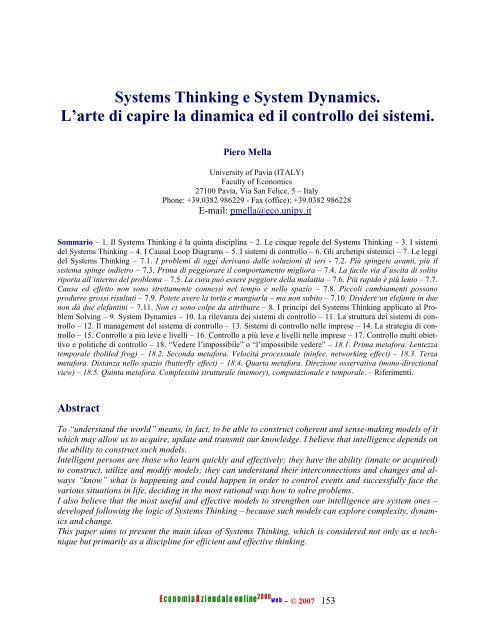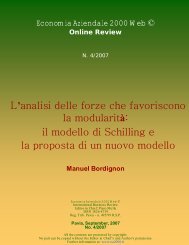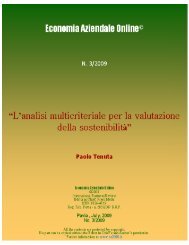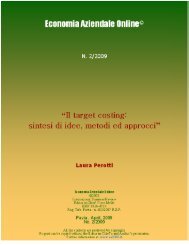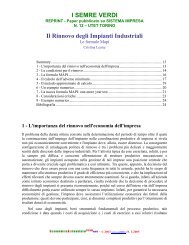Systems Thinking e System Dynamics. L'arte di capire la dinamica ...
Systems Thinking e System Dynamics. L'arte di capire la dinamica ...
Systems Thinking e System Dynamics. L'arte di capire la dinamica ...
- No tags were found...
Create successful ePaper yourself
Turn your PDF publications into a flip-book with our unique Google optimized e-Paper software.
<strong><strong>System</strong>s</strong> <strong>Thinking</strong> e <strong>System</strong> <strong>Dynamics</strong>.L’arte <strong>di</strong> <strong>capire</strong> <strong>la</strong> <strong>di</strong>namica ed il controllo dei sistemi.Piero Mel<strong>la</strong>University of Pavia (ITALY)Faculty of Economics27100 Pavia, Via San Felice, 5 – ItalyPhone: +39.0382 986229 - Fax (office): +39.0382 986228E-mail: pmel<strong>la</strong>@eco.unipv.itSommario – 1. Il <strong><strong>System</strong>s</strong> <strong>Thinking</strong> è <strong>la</strong> quinta <strong>di</strong>sciplina – 2. Le cinque regole del <strong><strong>System</strong>s</strong> <strong>Thinking</strong> – 3. I sistemidel <strong><strong>System</strong>s</strong> <strong>Thinking</strong> – 4. I Causal Loop Diagrams – 5. I sistemi <strong>di</strong> controllo – 6. Gli archetipi sistemici – 7. Le leggidel <strong><strong>System</strong>s</strong> <strong>Thinking</strong> – 7.1. I problemi <strong>di</strong> oggi derivano dalle soluzioni <strong>di</strong> ieri - 7.2. Più spingete avanti, più ilsistema spinge in<strong>di</strong>etro – 7.3. Prima <strong>di</strong> peggiorare il comportamento migliora – 7.4. La facile via d’uscita <strong>di</strong> solitoriporta all’interno del problema – 7.5. La cura può essere peggiore del<strong>la</strong> ma<strong>la</strong>ttia – 7.6. Più rapido è più lento – 7.7.Causa ed effetto non sono strettamente connessi nel tempo e nello spazio – 7.8. Piccoli cambiamenti possonoprodurre grossi risultati – 7.9. Potete avere <strong>la</strong> torta e mangiar<strong>la</strong> – ma non subito – 7.10. Dividere un elefante in duenon dà due elefantini – 7.11. Non ci sono colpe da attribuire – 8. I principi del <strong><strong>System</strong>s</strong> <strong>Thinking</strong> applicato al ProblemSolving – 9. <strong>System</strong> <strong>Dynamics</strong> – 10. La rilevanza dei sistemi <strong>di</strong> controllo – 11. La struttura dei sistemi <strong>di</strong> controllo– 12. Il management del sistema <strong>di</strong> controllo – 13. Sistemi <strong>di</strong> controllo nelle imprese – 14. La strategia <strong>di</strong> controllo– 15. Controllo a più leve e livelli – 16. Controllo a più leve e livelli nelle imprese – 17. Controllo multi obiettivoe politiche <strong>di</strong> controllo – 18. “Vedere l’impossibile” o “l’impossibile vedere” – 18.1. Prima metafora. Lentezzatemporale (boliled frog) – 18.2. Seconda metafora. Velocità processuale (ninfee, networking effect) – 18.3. Terzametafora. Distanza nello spazio (butterfly effect) – 18.4. Quarta metafora. Direzione osservativa (mono-<strong>di</strong>rectionalview) – 18.5. Quinta metafora. Complessità strutturale (memory), computazionale e temporale. – Riferimenti.AbstractTo “understand the world” means, in fact, to be able to construct coherent and sense-making models of itwhich may allow us to acquire, update and transmit our knowledge. I believe that intelligence depends onthe ability to construct such models.Intelligent persons are those who learn quickly and effectively; they have the ability (innate or acquired)to construct, utilize and mo<strong>di</strong>fy models; they can understand their interconnections and changes and always“know” what is happening and could happen in order to control events and successfully face thevarious situations in life, deci<strong>di</strong>ng in the most rational way how to solve problems.I also believe that the most useful and effective models to strengthen our intelligence are system ones –developed following the logic of <strong><strong>System</strong>s</strong> <strong>Thinking</strong> – because such models can explore complexity, dynamicsand change.This paper aims to present the main ideas of <strong><strong>System</strong>s</strong> <strong>Thinking</strong>, which is considered not only as a techniquebut primarily as a <strong>di</strong>scipline for efficient and effective thinking.- © 2007 153


